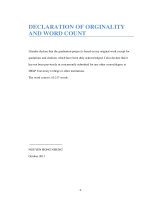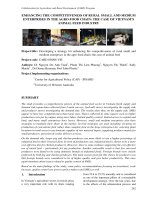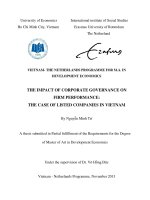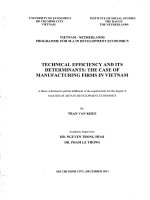Environmental impacts on small and medium enterprises effectiveness (the case of fisheries sector in Vietnam)
Bạn đang xem bản rút gọn của tài liệu. Xem và tải ngay bản đầy đủ của tài liệu tại đây (431.11 KB, 11 trang )
“The EUrASEANs: journal on global socio-economic dynamics”
Volume 2 (3); March - April, Year 2017;
ISSN 2539 – 5645 (Print)
Copyright © 2017, [The EUrASEANs]
on-line access: />
ENVIRONMENTAL IMPACTS ON SMALL AND MEDIUM
ENTERPRISES EFFECTIVENESS
(THE CASE OF FISHERIES SECTOR IN VIETNAM)
Tran Huu Ai
Nga Anh Huynh
Van Hien University, Ho Chi Minh City, Vietnam
This paper analyzes factors that determine the competitiveness of countries, cities or regions
in a global economy. To stimulate competitiveness authorities and business can use different
policies at the different geographical levels (country, región, city, clusters).
The objective of this paper is to make countries, cities or regions more competitive in a
global economy, by linking them up to global value chains. We will argue that clusters are
one way of increasing global competitiveness. Also competitiveness of cluster will be
discussed and policies to promote the competitiveness at different levels will be listed.
Finally, the factors influencing competitiveness will be analyzed.
Keywords: business performance, SMEs, managerial skills, policy, Vietnam
Introduction
Worldwide value chains can help small and medium-sized enterprises in agriculture,
forestry and fisheries to increase profits, take new opportunities from international economic
integration, to increase the value of Vietnam's agricultural products. Government has to
realize financial policies to support small and medium-sized enterprises in this sector in order
Tran Huu Ai
PhD, lecturer of Faculty of Economics, Van Hien University, Ho Chi Minh City, Vietnam
Research interests – markets of agricultural products, SMEs functioning and government support, organic food
markets, ecological economics, environmental issues of economic development and corporate social
responsibility
Published more tan 50 papers in International journals, member of editorial board of International journals
E-mail:
Nga Anh Huynh
Faculty of Economics, Van Hien University, Ho Chi Minh City, Vietnam
Research interests – markets of agricultural products, SMEs functioning and government support, organic food
markets, ecological economics, environmental issues of economic development and corporate social
responsibility
E-mail:
The EUrASEANs: journal on global socio-economic dynamics, № 2 (4), 2017
to develop financial capability for enterprises to implement high-tech applications and help
them to join the effective global chains.
According to the Chamber of Commerce and Industry of Vietnam (VCCI), the SME
sector accounts for an important place in the economy. The statistics said, SMEs account for
over 97% of all enterprises throughout the country, contributing 50% of GDP, 33% of state
budget revenues (the state budget), 62% creating jobs for laborers, contributing 49% on
creating added value for the economic organization... but this economic sectors still face
difficulties in accessing credit.
Based on Institute of SMEs Management survey, currently only about 30% of SMEs
have access to funding from banks and the remaining 70% should continue to use their own
capital or borrow from informal sources with detailed very high cost.
During 2012 - 2016 the growth rate of Vietnam aquaculture enterprises reached 12.6%
per year that is higher than rates of whole national business development (10.9% per year).
The proportion of aquaculture enterprises tends to diminish (compared to businesses
nationwide) from 1.61% in 2012 to 0.96% in 2016 (data was presented in seminar "Solution
unsecured financing for small and medium enterprises", held in Ho Chi Minh City, on
13/1/2016).
Considering business efficiency we can use indices such as profitability on assets
(POA), return on brand equity (ROE), profitability performance on sales (ROS) of
aquaculture enterprises.
POA of aquaculture enterprises in 2012 reached 15.1% and 11.8% in 2016. ROE of
fishery enterprises reached 19, 2% in 2012, 14.7% in 2015 compared to only 6.3% rate in
2012 and 6.65% in 2016 of business in general. ROS of aquaculture enterprises reached
10.6% (just over 4.5% for business in general). Along with higher profitability, performance
and degree of safety capital ratio accounted for the aquatic seafood business losses (35.1% in
2016) lower than other industries (44.8 % year 2016). However, we have to notice that the
proportion of the seafood business loss increased rapidly from 23.2% (2012) up to 35.1%
(2016). This suggests that the seafood business enterprises in Vietnam are still facing many
difficulties.
Theoretical Foundations and research models
Theoretical Foundations
Typically, SMEs face higher transaction costs than big enterprises in obtaining bank
credit (Saito & Villanueva, 1981) or financing for working capital (Peel & Wilson, 1996).
The researchers also identified difficult access to external financing and weak capital base,
lack of experience in the job sector, especially the lack of technical knowledge coupled with
management skills (that indicate a lack of planning and market research) (Van Stel & Storey,
2004). A study by the World Bank proposes that 90% of surveyed small businesses said that
credit is a major constraint in new investment (Parker et al., 1995). Many SMEs’ owners or
41
ENVIRONMENTAL IMPACTS ON SMALL
directors confirmed lack of the training and managerial experience, their acting based more
on intuition than analyze, active involvement in personal experience than working with a
long-term strategy (Hill, 1987).
Environmental regulations related to the storage and utilization of hazardous
substances might have a greater impact on agricultural, manufacturing, transport and media
business (Carter et al., 2004). Many SMEs operate in an environment of poor information
and the lack of business funding services and complete information technology infrastructure
(Oshikoya & Hussain, 2007).
The business performance of SMEs is complex issues connected to the elements of the
entire business process (Tab. 1).
Table 1 - Overview of theories on factors affecting SMEs efficiency
(compiled by co-authors)
Authors
Anne Ngima Kinyua (2014)
Mbugua Stephen Kamunge,
Agnes Njeru, Ondabu Ibrahim
Tirimba (2014)
Atsede Woldie, Patricia
Leighton, Adebimpe Adesua
(2008)
Levy et al., (2001)
Ben Malesi Mugodo (2014)
Scale of SMEs performance
Access to finance, macroeconomic environment,
infrastructure and management sciences
Access to finance, access to information services business,
management experience, infrastructure and government
regulation
Years of business activity, job size, business sector, legal
form, experience in industry, business motivation and the
age of the manager.
Degree holders, Access to finance, access to information
services business, experience management, infrastructure
and policies and government rules
Business access to information services, management
training and experience, policy and government regulation,
technical change, investment approach
Research Methods
Theoretical model has 5 independent variables measured by 28 observed variables and
dependent variable measured by 3 observed variables. The questions related to the impact of
information access, business services, access to financial resources, skills, management
experience, policies and regulations of government and access to infrastructure (Tab. 2).
The survey was run out in the period from from September, 2015 to December, 2015,
brought directly through a paper questionnaire or by email to SMEs in Vietnam. 350 direct
questionnaires were sent, 284 questionnaires were collected. 21 questionnaires were
eliminated because the information is not fully provided; the last 263 questionnaires were
used for conducted analysis. Stratified sampling method was applied to randomly collect
primary data (Amman et al, 2012). The concept of reflection is measured on a scale of 7
point Likert (1: strongly disagree to 7: completely agree). To ensure that content and
42
The EUrASEANs: journal on global socio-economic dynamics, № 2 (4), 2017
intention of questionnaire are clear and understandable for respondents, it was checked
before by seven experts in the fields of business and international economy.
The scale reliability was assessed through Cronbach's alpha coefficient. If observed
variables have a correlation coefficient of total variation (item-total correlation) less than 0.4
they will be disqualified. Scale is accepted as Cronbach's coefficient alpha reliability of 0.6
or higher (Schmitz-Justen & Wilhelm, 2007) Coefficient of KMO (Kaiser-Mayer-Olkin) ≥
0.5 and a significance level of Bartlett test ≤ 0.05. KMO is a criteria to consider the
appropriateness of the EFA, suitable is 0.5 ≤ KMO ≤ 1. (J. Pallant, 2001).
Table 2 - The scale of the variables in the model proposed
(compiled by co-authors)
Original Scale
Access to information services business
Original author scale
Oshikoya & Hussain, (2007), Levy, (2000)
Management skills
King& McGrath, (2002), Cant and Lightelm (2003)
Access to finance
Dia (1996), Kallon (1990)
Access infrastructure development
(Rozee, 2003), Ombura (1997)
Policies and government regulations
Business performance of SMEs
Mintzberg (2009), Wanjohi, 2009) Mussnig, (2007)
Ntakobajira (2013), Kazooba (2006)
Table 3 - Features of SME’s involved in conducted survey
(compiled by co-authors)
Number of years in operation
Frequency
Frequency Rate (%)
(%) Cumulative
1 – <5 years
36
13,69
13,69
5 – <10 years
124
47,15
60,84
10 - <15 years
89
33,84
94,68
>15 years
14
5,32
100,0
Total
263
100,00
5 hypotheses were set:
H1: There is a positive relationship between access to financial resources and business
efficiency
H2: There is a positive relationship between management skills and business
performance.
H3: There is a positive relationship between government policy and regulations and
business efficiency.
H4: There is a positive relationship between access infrastructure development and
business efficiency.
43
ENVIRONMENTAL IMPACTS ON SMALL
H5: There is a positive relationship between accesses to information services business
to business efficiency.
Results and Discussion
Descriptive statistics
Survey results showed that 47.15% were active SMEs from 5 - <10 years, 33.84% have
been operating since 10 - <15 years, 13.69% have been operating since 1 <5 years, while
5.32% were active> 15 years (Tab. 3). These respondents included 74.9% owner, 18.7%
supervisors / employees and 6.4% are partners.
62.1% of respondents said that it’s very difficult for SME to get financial resources
(Tab. 4).
64.4% of respondents alleged that high interest rate; high cost of services limit SMEs
abilities to access bank loans.
Table 4 - Effect of loans on SMEs’ business performance
(compiled by co-authors)
The response rate (%)
Medium High
Nothing Low level
level
level
Content
Lack of financial records makes it difficult to access
enterprise credit
Most financial institutions are reluctant to provide
long-term credit for SMEs
High interest rates, monetary values and expenses
incurred in processing the dossiers for SME loans
make difficult access to funding from banks
1.7
5.0
30.3
62.1
0.0
1.3
25.3
73.4
0.0
0.9
34.7
64.4
65.2% of respondents sure those SMEs intangible assets are undervalued and it also
causes many difficulties to access bank loans (Tab. 5).
66.7% of respondents said that SMEs does not own the assets with great value.
Table 5 - Effect of requirements on collateral for SMEs’ business performance
(compiled by co-authors)
Content
Intangible assets are underestimated by banks
Small and medium enterprises are not enough
collateral
SMEs do not have valuable assets
44
The response rate (%)
Medium High
Nothing Low level
level
level
0.7
3.6
30.5
65.2
0.9
1.2
36.3
61.6
2.4
1.4
29.5
66.7
The EUrASEANs: journal on global socio-economic dynamics, № 2 (4), 2017
59.4% of respondents said that SMEs need strict cash management to consider net
income using (Tab. 6).
36.0% of respondents said that SMEs need to keep good corporate financial indicators.
32.4% of respondents said that SMEs differ in terms of capital and income.
Table 6 - Effect of financial management for the business performance of SMEs
(compiled by co-authors)
The response rate (%)
Nothing Low level
Content
Cash must be managed well and the owners are not
drawn without consideration to net income
SME maintains good financial indicators
SMEs differ in terms of capital and income.
Medium
level
High
level
25.4
12.8
59.4
2.4
58.2
58.3
5.8
9.3
31.5
29.5
4.5
2.9
Majority of surveyed SMEs are less likely to comply with the standards of urban
planning, trading standards and the client's interests and property rights (Tab. 7).
Table 7 - Influence policies and regulations applicable of SMEs business performance
(compiled by co-authors)
The response rate (%)
Content
Nothing Low level
Companies are required to comply with the property
rights
Companies are required to comply with tax laws and
financial reporting
Companies are required to comply with labor
standards and health and safety
Companies are required to adhere to environmental
protection
Companies are required to comply with urban
planning
Companies are required to comply with trading
standards and the interests of customers
Medium
level
High
level
77.3
3.6
17.2
1.9
26.4
4.2
24.6
44.8
52.3
6.2
24.2
173
21.4
9.2
38.1
31.3
80.6
1.8
13.4
4.2
87.7
3.4
6.4
2.5
Most of interviewed proprietors or managers said that they did not receive any business
skills trainings such as business planning, network programming, and partnership. Generally
speaking skills for line management of SMEs should be improved further (Tab. 8).
Most of the proprietors or SMEs’ managers answered that infrastructure (electricity,
water and sugar) has high impact on business performance (respectively 69.8%, 68.2% and
54.1%), while land use is much less important (37.5%)(Tab. 9).
45
ENVIRONMENTAL IMPACTS ON SMALL
Table 8 - Business skills effects on SMEs’ business performance
(compiled by co-authors)
The response rate (%)
Medium High
Nothing Low level
level
level
61.4
3.1
23.1
12.4
74.2
3.6
17.5
4.7
Content
Received training in business skills
Trained on the draft of the business plan
Trained in productivity and environmental
awareness
Received training in network programming.
partnerships and joint ventures
87.4
3.4
7.2
2.0
78.5
5.4
6.7
9.1
Table 9 - Influence of infrastructure on SMEs business performance
(compiled by co-authors)
Content
Electricity and water prices
Have full power. the country's business sector
enterprises
Convenient transportation for business enterprises
Premises (land use) suitable for business
The response rate (%)
Low Medium High
Nothing
level
level
level
1.6
23.0
68.2
5.7
0.0
26.8
69.8
3.4
2.0
36.6
35.3
24.3
54.1
37.5
8.6
1.6
Explore factor analysis (EFA)
EFA analysis results showed that 5 extracted factors have individual value 1.397, the
Total variance extracted is 76.176% > 50%. KMO = 0.885 > 0.5, the statistical significance
test 6132.370 Bartlett with Sig = 0.000 < 0.05. Therefore, the observed variables satisfy the
conditions and used to analyze the Confirming factor analysis (CFA).
Confirming factor analysis (CFA)
We considered the relationship between observed and unobserved variables (Podsakoff
et al., 2003). According to J. Ford, R. MacCallum and M. Tait (1986), the value of the load
points for each component standards the minimum threshold of 0.40 at the 5% significance.
In Tab. 10, all values presented.
46
The EUrASEANs: journal on global socio-economic dynamics, № 2 (4), 2017
Table 10 - Test results worth distinguishing between the components of the scale
(compiled by co-authors)
Correlate
AISB
<-->
MS
AISB
<-->
PGR
AISB
<-->
AC
AISB
<-->
AID
MS
<-->
PGR
MS
<-->
AC
MS
<-->
ID
PGR
<-->
AC
PGR
<-->
AID
AC
<-->
AID
CR: Critical values; SE: Standard error
R
0.098
0.111
0.112
0.078
0.136
0.173
0.044
0.088
0.047
0.074
S.E.
0.025
0.026
0.025
0.025
0.026
0.028
0.023
0.023
0.024
0.023
C.R.
3.850
4.304
4.516
3.082
5.258
6.230
1.927
3.823
1.994
3.263
Value P
***
***
***
0.002
***
***
0.050
***
0.046
0.001
Linear structural analysis indicates that the model chi-squared value statistics is
259.310 with 139 degrees of freedom and the value of P = 0.000, chi-squared relative
freedom under Cmin/def is 1,866 (< 2). Other indicators such as GFI = 0.909 (> 0.9), TLI =
0.962 (> 0.9), CFI = 0.969 (> 0.9) and RMSEA = 0.057 (< 0.08). Therefore, this model fits
the gathered data. This also permits a separate assessment of the observed variables
development. On the convergence value, standard scales must be > 0.5 and statistically
significant with p < 0.05, so the scale achieved convergence value.
Result structural model
Structure model (SEM) was carried out to find relationship between the structure of
business information services, management skills, infrastructure (infrastructure), capacity
financial resources and policies and government regulations. Results showed that the model
value after calibration with chi-squared statistic is 115.791, with 81 degrees of freedom (P =
0.007), chi-squared relative freedom under Cmin/df is 1,430 (< 2). Other indicators such as
GFI = 0.946 (> 0.9), TLI = 0.986 (> 0.9), CFI = 0.989 (> 0.9) and RMSEA = 0.040 (<0.08).
Therefore, this model has achieved compatibility with collected data.
Table 11 - Results of estimation relationships between the elements of business performance
(compiled by co-authors)
BE
BE
BE
Relations
<--<--<---
AISB
MS
AID
Estimate
0.136
0.440
0.357
47
S.E.
0.050
0.061
0.162
C.R.
2.718
7.200
2.203
P
0.007
***
0.028
Label
Accept
Accept
Accept
ENVIRONMENTAL IMPACTS ON SMALL
Figure 3 - Result from the relational structure in the final model (SEM)
(created by co-authors)
Check the reliability of the estimates by Bootstrap
Bootstrap method was used to test the model estimates the final model with repetition
pattern is N = 1000. The estimation results from 1000 samples are averaged together with the
deviation is shown in Tab. 12, CR absolute value is less than 2, it can be said that deviation is
very small; while no statistically significant at the 95% confidence level. Thus, we can
conclude that the model can be trusted. There are three valuable relationships theoretically.
Table 13 - The results estimated by bootstrap with N = 1000
(compiled by co-authors)
Estimate normal
BE
BE
BE
Parameter
<--AISB
<--MS
<--ID
Estimate
0.136
0.440
0.357
SE
SE-SE
0.057 0.001
0.086 0.002
0.207 0.005
Estimate Bootstrap N=1000
Mean
0.133
0.435
0.377
Bias
SE-Bias
CR
-0.003
-0.004
-0.019
0.002
0.003
0.007
-1.500
-1.333
- 2.714
Results
The answers showed that factors of management skills (finance, marketing and
leadership skills) affect the SMEs’ business performance (ES = 0.440, P = 0.000, P < 0.05).
Access elements of infrastructure (water, roads, electricity and land) affect the SMEs’ job
performance (ES = 0.357, P = 0.028, P < 0.05). Factors access business information services
(infrastructure, information technology and information technology costs) also affect the job
48
The EUrASEANs: journal on global socio-economic dynamics, № 2 (4), 2017
performance of SMEs (ES = 0.136, P = 0.007, P < 0.05). Finally, elements of access to
financial resources (ES = 0.019, P = 0.742, P > 0.05), and policies and government
regulations (ES = 0.013, P = 0.344, P > 0.05) do not impact on the business performance of
SMEs.
Conclusions and recommendations
SME sector has an important role in economic development, poverty reduction and job
creation. The sector faces a number of difficulties, especially in access to finance and
markets; training and technology which greatly affect the efficiency of the business. The
objective of this study was to determine the factors affecting the SMEs’ performance in
Vietnam. The study results showed that factors of financial resources and government
regulations can affect business performance improvement. The important factors that affect
the business performance of SMEs of fisheries sector in Vietnam are also information access
business services, skills management experience and access to infrastructure.
Based on the research findings few recommendations can be suggested:
- need to provide information for the SMEs business in Vietnam. The government
should organize seminars to support SMEs. Other development partners such as banks and
credit organizations should guide the better using of loans for SMEs.
- government should help SMEs organizing training courses for job skills and basic
financial management. This will enhance the business skills to help them to identify and
exploit business opportunities and establish good business decisions.
- develop better infrastructure, particularly road traffic systems and wharf. In addition,
government should have policies to promote companies to move their plants by providing tax
incentives and financial support.
References
Aman, A. H. L., Harun, A. & Hussein, Z. (2012). The influence of environmental knowledge and
concern on green purchase intention the role of attitude as a mediating variable. British Journal
of Art and Social Sciences, 7 (2).
Kinyua, A. N. (2014). Factors Affecting the Performance of Small and Medium Enterprises in the
Jua Kali Sector In Nakuru Town, Kenya. Journal of Business and Management, 16(1).
Woldie, A., Leighton, P. & Adesua, A. (2008). Factors influencing small and medium enterprises
(SMEs): an exploratory study of owner/manager and firm characteristics. Banks and Bank
Systems, 3(3).
Dia, M. (1996). African management in the 1990s and beyond: Reconciling indigenous and transplant
institutions. Washington, D.C.: The World Bank. Economic Development and Cultural
Change, 32(2).
Hill, T. (1987). Satisfaction and Consumer Services. Advances in Consumer Research, 3(5), 311-325.
Lader, P. (1996). The Public/Private Partnership, Springs Spring, 35(2).
Levy, M., Powell, P. & Yetton P. (2001). SMEs: Aligning is and the strategic context. Journal of
Information Technology, 16(3).
49
ENVIRONMENTAL IMPACTS ON SMALL
Lichtenstein B.M. & Brush, C.G. (2001). How do resource bundles develop and change in new
ventures? A dynamic model and longitudinal exploration. Entrepreneurship theory and
practice, 25(3).
Kamunge, M., Njeru, A. & Ibrahim Tirimba, O. (2014). Factors Affecting the Performance of Small
and Micro Enterprises in Limuru Town Market of Kiambu County, Kenya. International
Journal of Scientific and Research Publications, 4(12).
Mintzberg, H. & Van der Heyden, L. (1999). Organigraphics: Drawing How Organizations Really
Work. Harvard Business Review, 4(7).
Ben Malesi, M. (2014). Factors Affecting Growth of Small Scale Real Estate Companies IN Trans Nzoia County: A Case of Setmark Properties. The Management University of Africa, 23(9).
Ombura, C.O. (1997). Towards an environmental planning approach in urban industrial siting and
operations in Kenya: The case of Eldoret Town. Faculty of Environmental Sciences
University of Amsterdam, 4(3).
Oshikoya, T. W. & Hussain, M. N. (2007). Information Technology and the Challenge of Economic
Development in African E-Markets Information and Economic Development. Economic
Commission for Africa, 36 (1).
Parker, R., Riopelle, R. & Steel, W., (1995). Small Enterprises Adjusting to Liberalisation in Five
African Countries, World Bank Discussion Paper, 17 (3).
Peel, M. & Wilson, N. (1996). Working Capital and Financial Management Practices in the Small
Form Sector. International Small Business Journal, 14(2).
Pallant, J. (2001). The SPSS survival manual: A step-by-step guide to data analysis using SPSS for
Windows (version 10). St Leonards, NSW: Allen & Unwin.
Saito, K. & Villanueva, D. (1981). Transactions costs of credit to the small-scale sector in the
Philippines. Economic Development and Cultural Change, 29(3).
Sentosa, I. et al. (2012). A Structural Equation Modeling of Internet Banking Usage in Malaysia.
Journal of Arts, Science and Commerce, 3(1), 75-86.
Schmitz-Justen, F. J., & Wilhelm, A. F. (2007). An empirical study of factors impacting on
knowledge processes in online forums: Structural equation modeling analysis and results.
International Journal of Web Based Communities, 3(3).
Van Stel, A. J., & Storey, D. J. (2004). The link between firm births and job creation: Is there a up as
tree effect?, Regional Studies, 38(8).
Wanjohi, A. (2009). Challenges Facing SMEs in Kenya, Journal of Business Venturing 8(2).
Paper submitted
Paper accepted for publishing
Paper pubslihed on-line
50
14 February 2017
21 March 2017
24 March 2017









